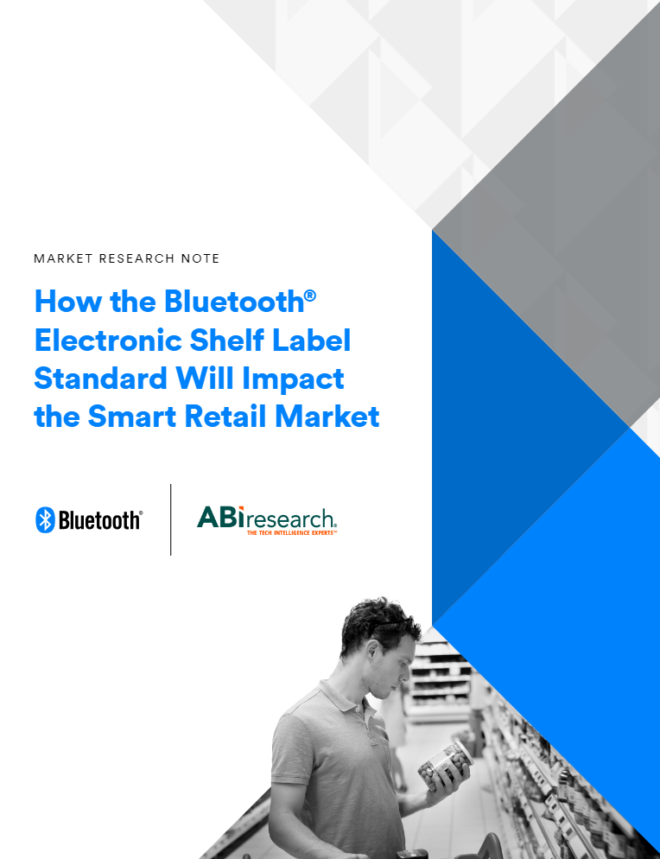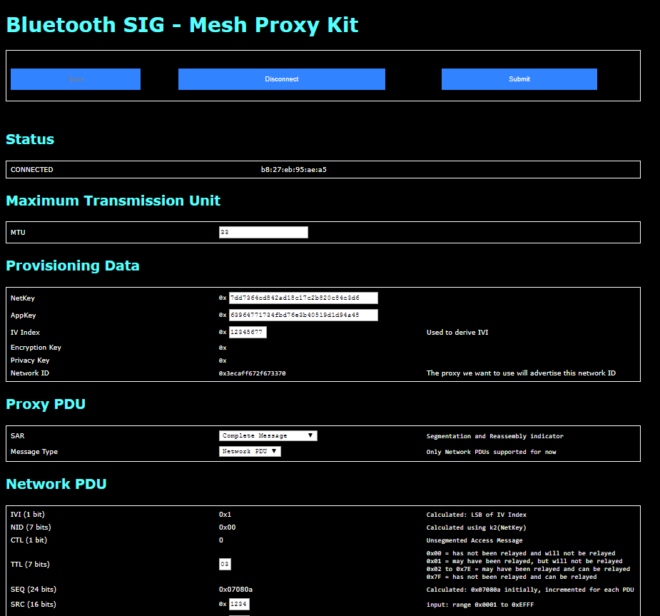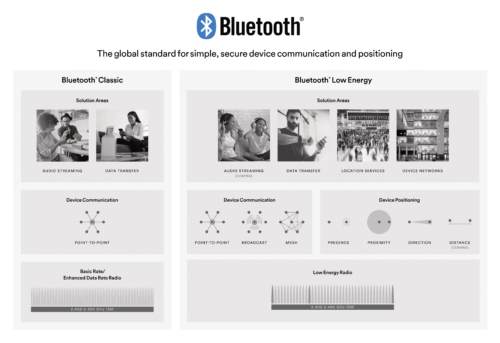Electronic shelf label (ESL) systems have historically relied on proprietary protocols for wireless communication, presenting a barrier to global adoption. To address this challenge, leaders from the ESL industry teamed with the Bluetooth Special Interest Group (SIG) to create a scalable, ultra-low power, highly secure ESL wireless standard based on Bluetooth® technology.
This article highlights the benefits of ESL and outlines the features and specifications that will enable standardized Bluetooth ESL.
Electronic Shelf Labels

Electronic shelf labels (ESL) are devices that are attached to shelves in settings like large supermarkets. An ESL has a display used to show images that contain information such as the name, description, and the price of the product on the shelf.
ESLs often have LEDs for attracting attention and sensors for collecting data like the ambient temperature. Using wireless communication, a central device known as an access point (AP) can send commands for changing prices, enabling LEDs, or collecting sensor data, for example.
An AP is a wireless networking device that transmits and receives data over a wireless local area network (WLAN) and is typically integrated with relevant enterprise systems.
ESL use cases include:
- Changing the price of individual products or groups of products. Imagine discounting all freshly baked bread an hour before closing every day to ensure it is sold while at its best.
- Illuminating the red LED on a series of unrelated products to help a shop worker find and collect the items in a customer’s order.
- Monitoring the temperature of refrigerators.
The wireless communication system used with ESLs must support a large, one-to-many topology with a single AP able to communicate with thousands of ESLs. The communication capability must be bidirectional, with ESLs able to send responses to commands from the AP.
ESLs are usually powered by small batteries, which must last several years.
![]()
FEATURED RESOURCES
Bluetooth® Core Specification Version 5.4 Technical Overview
This paper details new features and updates included in Bluetooth Core Specification Version 5.4.
The Bluetooth Logical Transports
Bluetooth® Low Energy (LE) supports several modes of operation known as logical transports.
Connection-oriented communication allows a single central device to communicate in a bidirectional fashion but with a relatively small number of simultaneously connected devices.
Connectionless communication, known as advertising, is available in several different forms and allows a device called a Broadcaster to communicate with very large numbers of receiver devices known as Observers. Before the latest release of the Bluetooth Core Specification, advertising supported unidirectional data communication only.
Historically, the ESL market has been hampered by a lack of standardization, especially concerning wireless communication, where proprietary 2.4 GHz solutions are common. This has led to considerable fragmentation, vendor lock-in, and market growth headwinds.
According to ABI Research, 2.4 billion ESL devices are estimated to be installed by 2027. The adoption of standards is expected to drive substantial growth in this market.
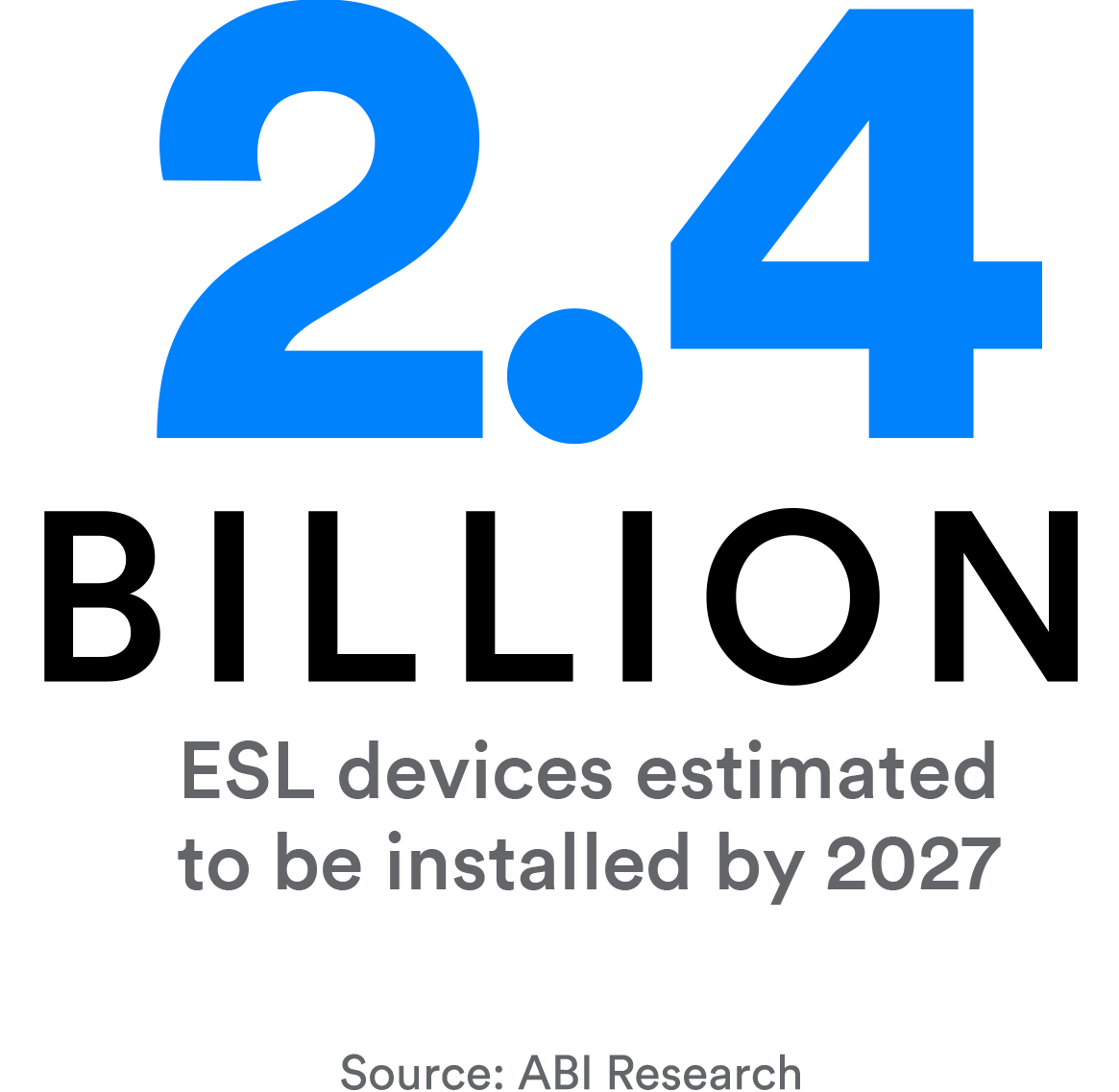
Periodic Advertising with Responses
Bluetooth Core 5.4 introduces a new logical transport called Periodic Advertising with Responses (PAwR). PAwR uses advertising and supports large one-to-many topologies. In contrast to other Bluetooth® advertising modes, it supports bidirectional application data communication.
The periodic part of the PAwR name refers to the broadcasting of packets by a central device like an access point, which takes place at precisely timed, regular intervals. Communication takes place in bursts of activity during periods of time called events. Events are divided into subevents.

Figure 2 – PAwR events and subevents
Subevents are further divided into time slots which are used for the transmission of one packet by the central Broadcaster device, followed by several time slots during which to receive responses from Observer devices.

PAwR defines procedures by which Observer devices can acquire the event and subevent schedule of the Broadcaster. Other procedures define how the Observer is allocated a specific subevent during which to listen and a response slot within that subevent to use for replies.
Assigning devices to specific subevents only means that they switch into receive mode infrequently, substantially increasing battery life.
PAwR is designed to accommodate data that changes at every transmission and is delivered to individual or groups of devices. Application logic ensures that data transmitted in each subevent is relevant to the devices listening at that time, so there is little wasted energy.
PAwR is essentially stateless, and this makes it very scalable. Bi-directional, one-to-many communication involving thousands of devices like ESLs is achievable using PAwR.
FEATURED INNOVATION
Bluetooth Electronic Shelf Labels (ESL)
With the introduction of a wireless standard for the electronic shelf label (ESL) market, Bluetooth® technology will help unlock the next phase in retail digital transformation to deliver better retail outcomes for both stores and shoppers.
The Bluetooth Electronic Shelf Label Profile
The Bluetooth Electronic Shelf Label profile specification enables standardized, interoperable ESL products that use Bluetooth® LE to be created.
The profile specification includes an addressing scheme and a series of commands and parameters which an AP may transmit to one or more ESL devices in a single packet sent during a PAwR subevent.
ESLs are members of groups, of which there may be 128, each with a numeric ID. Each group may have 255 ESL devices, each with a numeric ID. The unique address of an individual ESL in the whole network is a combined Group ID and ESL ID, and, consequently, an ESL network can contain up to 32,640 electronic shelf labels, each of which can be controlled from a single access point.
Before a new ESL can be used, it has to go through a set-up procedure. This involves the AP connecting to the ESL, allocating it an address in the network, and, typically, transferring a series of images to it. PAwR event and subevent details are passed to the ESL over the same connection. The assigned ESL Group ID determines the subevent to be used, whereas response slots are allocated dynamically, using standardized message processing logic.
ESL commands and responses are encrypted and authenticated using the AES-CCM algorithm to secure communication between the AP and ESLs. This capability is made possible by another new Bluetooth LE feature called Encrypted Advertising Data.
ESL and PAwR in Action
Figure 2 shows an exchange between an access point and several ESL devices over several subevents.

Conclusion
ESL systems enable dynamic pricing automation, more efficient store operations, and, perhaps most importantly, an increase in shopper satisfaction. New Bluetooth® technology features, developed by ESL industry leaders and the Bluetooth SIG, herald the arrival of a new industry standard for the electronic shelf label market. An important next step is for ESL solution providers to migrate their systems to standards-based wireless technologies, making it possible to expand their total addressable market. With the introduction of a wireless standard for the electronic shelf label (ESL) market, Bluetooth technology is helping unlock the next phase in retail digital transformation to deliver better outcomes for both stores and shoppers.
FEATURED INNOVATION
Bluetooth Electronic Shelf Labels (ESL)
With the introduction of a wireless standard for the electronic shelf label (ESL) market, Bluetooth® technology will help unlock the next phase in retail digital transformation to deliver better retail outcomes for both stores and shoppers.
電子棚札(ESL)システムでは従来、各社独自の無線通信プロトコルが使用されており、グローバルでの普及を妨げる大きな要因となっていました。この課題を解決すべく、ESL業界を代表する各社とBluetooth SIG(Special Interest Group)が協力し、Bluetooth®技術を基に、拡張性があり、超低消費電力で高セキュリティのESL無線規格を策定しました。
この記事ではESLのメリットにスポットライトを当てながら、標準化されたBluetooth ESL規格を支える機能や仕様を概観します。
電子棚札
電子棚札(ESL)は、大きなスーパーマーケットなどで商品棚に設置され、棚に並ぶ商品の名称、説明、価格などをディスプレイに表示するデバイスです。

多くの場合ESLには、 人目を引くためのLEDや、周辺温度などのデータを収集するためのセンサーが搭載されています。アクセスポイント(AP)と呼ばれるセントラルデバイスから、無線通信を使用して、価格変更、LEDの点灯、センサーデータの収集といったコマンドの送信が可能です。
アクセスポイント(AP)は無線LAN(WLAN)でデータを送受信する無線ネットワークデバイスで、通常は関連するエンタープライズシステムに組み込まれています。
ESLには以下のようなユースケースがあります。
- 個々の商品または商品群の価格表示を変更します。焼きたてのパンが最高の状態であるうちに売れるよう、閉店1時間前に一斉に値引きをする場合などが考えられます。
- 赤色のLEDを点灯し、一連の商品を見つけやすくします。買い物客が注文した商品を店員が探しながら集めて回る場合などに役立ちます。
- 冷蔵庫の温度を監視します。
ESLの無線通信システムは、1台のアクセスポイント(AP)が何千ものESLと通信できる大規模な1対多のトポロジーである必要があります。双方向通信が可能な必要があり、それによりアクセスポイント(AP)から送られてきたコマンドに対するESLからの応答が可能になります。
ESLは通常、数年の持続期間がある小型バッテリーで駆動します。
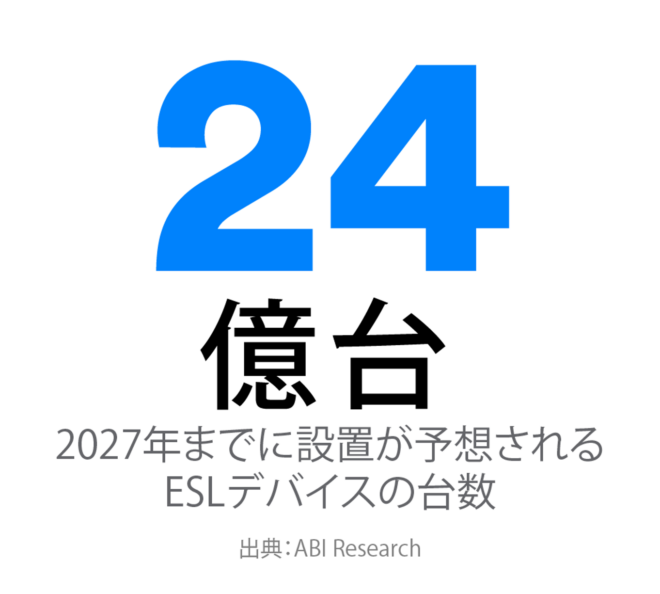
Bluetoothの論理トランスポート
Bluetooth®︎ LE(Low Energy)には、「論理トランスポート」と呼ばれる複数の動作モードがあります。
コネクション型コミュニケーションの場合、1台のセントラルデバイスとの双方向通信はできますが、同時に接続できるデバイスの台数は比較的少なくなります。
「アドバタイズ」として知られるコネクションレス型コミュニケーションにはいくつかの形態があり、「ブロードキャスター」と呼ぶデバイスが、「オブザーバー」と呼ぶ非常に多数の受信デバイスを相手にコミュニケーションできます。しかしBluetooth コア仕様の最新版が公開されるまでは、アドバタイズでは一方向のデータ通信しか行えませんでした。
これまでESL市場は、特に無線通信に関して標準化されていないことが普及を阻害する要因となっていました。無線通信では一般的に各社独自の2.4GHzソリューションが使用されていますが、このために市場が断片化されてベンダーロックインが発生し、市場拡大への逆風となっていました。
ABI Researchによると、2027年までに24億台のESLデバイスの設置が予想されています。標準規格の採用は、市場が実質的に成長するための原動力として期待されます。
PAwR(レスポンス付き定期アドバタイズ)
Bluetoothコア仕様5.4では、PAwR(レスポンス付き定期アドバタイズ)という新しい論理トランスポートが導入されました。PAwRはアドバタイズを使用して1対多のトポロジーを実現します。またBluetooth®︎の他のアドバタイズモードと異なり、双方向のアプリケーションデータ通信が可能です。
PAwRの名称にある「定期(Periodic)」とは、アクセスポイント(AP)のような中央デバイスが行うパケットのブロードキャストが、厳密なタイミングで一定間隔を置きながら行われることを指します。通信は、「イベント」と呼ばれる一連の集中的な活動期間中に行われます。イベントはいつくかの「サブイベント」に分けられます。
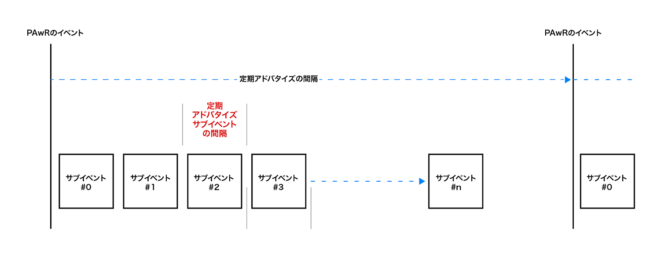
サブイベントはさらにタイムスロットに分けられます。最初のタイムスロットで中央のブロードキャスターデバイスがパケットを一つ送信し、その後オブザーバーデバイスからの応答を受け取るいくつかのタイムスロットが続きます。
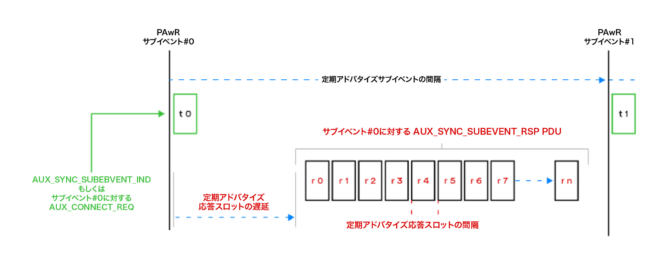
PAwRでは、オブザーバーデバイスがブロードキャスターからイベントおよびサブイベントのスケジュールを入手する手順が定義されています。また、オブザーバーが受信待機するサブイベントと、そのサブイベント内で応答に使う応答スロットを割り当てるための手順も定められています。
デバイスを特定のサブイベントに割り当てることにより受信モードへの切り替えが減るため、実質的なバッテリー寿命を伸ばすことができます。
PAwRは、通信のたびに異なり、個々のデバイスまたはデバイスグループに届けられるデータを収容するよう設計されています。アプリケーションロジックにより、各サブイベントで送信されるデータはそのとき受信待機しているデバイスに関連するものになるため、エネルギーの浪費を抑えることができます。
PAwRは基本的にステートレスであるため非常に高い拡張性を備えます。このPAwRの活用により、ESLのように数千にも及ぶ多数のデバイスを含む1対多の双方向通信が可能になるのです。
ESLプロファイル
ESLプロファイル仕様が可能にするのは、Bluetooth®︎ LEを使用し、標準化され相互運用性のあるESL製品の実現です。
プロファイル仕様は、アドレス指定スキームと一連のコマンドおよびパラメータを含んでいます。アクセスポイント(AP)はそれらを、PAwRサブイベント中に送信する単一のパケットによって、単一または複数のESLデバイスに向け送信できます。
ESLはグループとしてまとめられます。グループの数は最大で128となり、各グループには数値IDが付与されます。1グループは最大255のESLを持つことができ、ESLにもそれぞれ数値IDが付与されます。ネットワーク全体におけるESLの固有アドレスは、グループIDとESL IDの組み合わせとなります。したがって、1つのESLネットワークには最大32,640個までの電子棚札を入れることができ、それらを1つのアクセスポイント(AP)から管理できます。
新しいESLは、使用する前にセットアップの実施が必要です。セットアップではアクセスポイント(AP)がESLに接続し、ネットワーク内でのアドレスをESLに割り当てて、通常では一連の画像を送信します。PAwRのイベントおよびサブイベントの詳細もまた、このときの接続を通じてESLに渡されます。ESLに割り当てられるグループIDによって、使用されるサブイベントが決まります。応答スロットは、標準化されたメッセージ処理ロジックを使用し動的に割り当てられます。
アクセスポイント(AP)とESL間の通信セキュリティ確保のため、ESLのコマンドと応答はAES-CCMアルゴリズムを用いて暗号化および認証されます。これを可能にするのは、Bluetooth LEのもう一つの新機能である「Encrypted Advertising Data」です。
ESLとPAwRの実際の動き
図4は、1つのアクセスポイント(AP)と複数のESL間でのやり取りを、いくつかのサブイベントにわたり図示したものです。
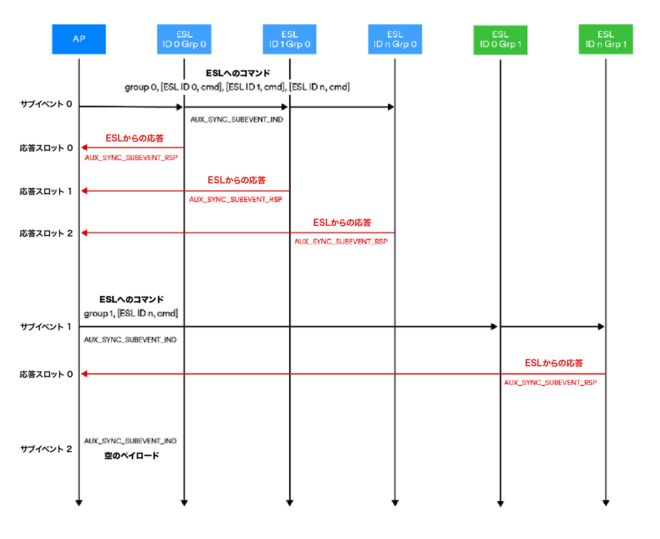
まとめ
ESLシステムが可能にするのは、動的な価格表示の自動化と店舗運営の効率化、そしておそらくは最も重要な点である、買い物客の満足度向上です。ESL業界のリーダーとBluetooth SIGが開発したこのBluetooth®︎技術の新機能は、ESL市場に新しい業界標準の到来を告げています。次の重要なステップは、ESLソリューションプロバイダーが各社のシステムを標準ベースの無線技術へと移行させ、TAM(獲得可能な最大市場規模)の拡大を可能にすることです。ESL市場に無線規格をもたらすことにより、Bluetooth技術は小売業界がデジタルトランスフォーメーションの新たなフェーズを切り開くことを支援し、店舗と買い物客の双方にメリットをもたらすより良い事業運営を可能にします。














